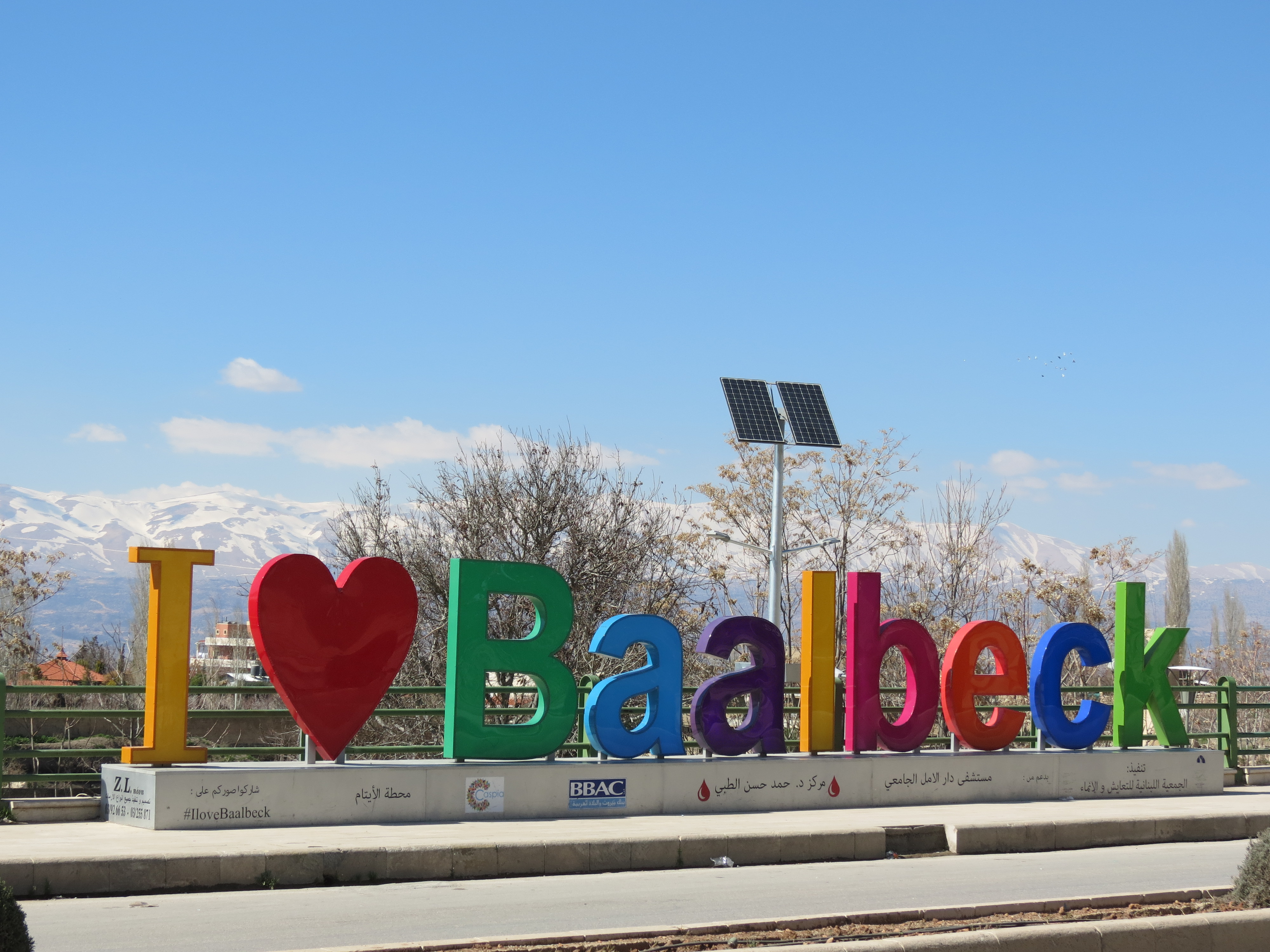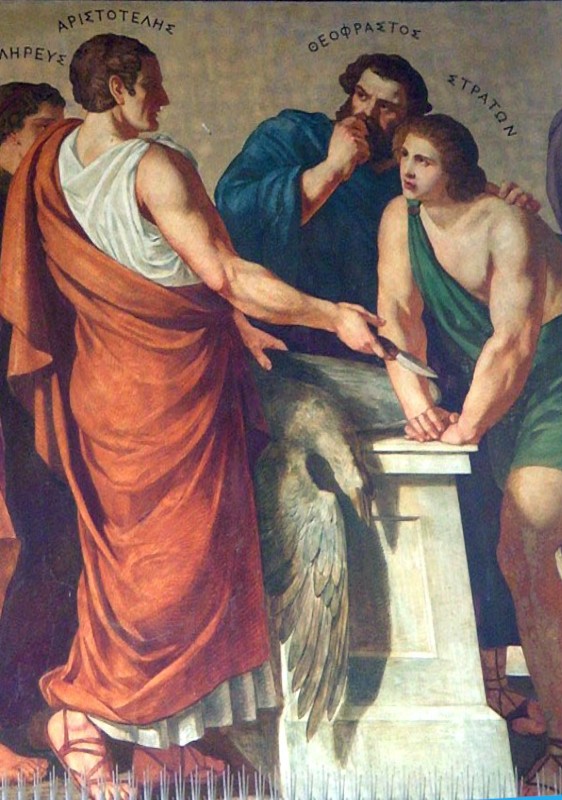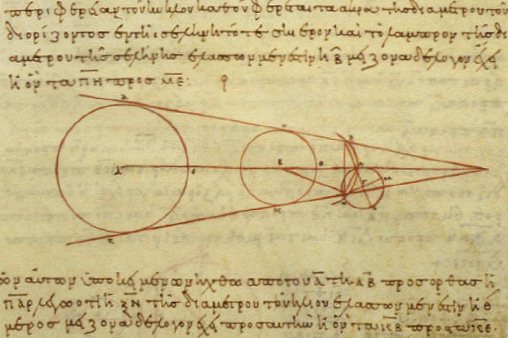|
Costa Ben Luca
Qusta ibn Luqa (820–912) (Costa ben Luca, Constabulus) was a Syrian Melkite Christian physician, philosopher, astronomer, mathematician and translator. He was born in Baalbek. Travelling to parts of the Byzantine Empire, he brought back Greek texts and translated them into Arabic. Personal life Qusta ibn Luqa al-Ba'albakki, i. e. from Baalbek or Heliopolis, modern-day Lebanon, a Melkite Christian, was born in 820 and flourished in Baghdad. He was a philosopher, physician, mathematician and astronomer. He died in Armenia possibly in A.D. 912/913. Translations Translations of Diophantos, Theodosius of Bithynia's ''Sphaerica'', ''On Days and Nights (Περὶ ἡμερῶν καὶ νυκτῶν -De diebus et noctibus)'', ''On the places of habitation'' (''Περὶ οἰκήσεων - De habitationibus''), Autolycus' ''On the moving sphere'' (''Περὶ κινουμένης σφαίρας'' - ''De sphaera quae movetur), On Risings and Settings'' (''Περὶ ἐπιτ ... [...More Info...] [...Related Items...] OR: [Wikipedia] [Google] [Baidu] |
Baalbek
Baalbek (; ar, بَعْلَبَكّ, Baʿlabakk, Syriac-Aramaic: ܒܥܠܒܟ) is a city located east of the Litani River in Lebanon's Beqaa Valley, about northeast of Beirut. It is the capital of Baalbek-Hermel Governorate. In Greek and Roman times Baalbek was also known as Heliopolis (, Greek for "Sun City"). In 1998 Baalbek had a population of 82,608, mostly Shia Muslims, followed by Sunni Muslims and Christians. It is home to the Baalbek temple complex which includes two of the largest and grandest Roman temple ruins: the Temple of Bacchus and the Temple of Jupiter. It was inscribed in 1984 as an UNESCO World Heritage site. Name A few miles from the swamp from which the Litani (the classical Leontes) and the Asi (the upper Orontes) flow, Baalbek may be the same as the ''manbaa al-nahrayn'' ("Source of the Two Rivers"), the abode of El in the Ugaritic Baal Cycle discovered in the 1920s and a separate serpent incantation. Baalbek was called Heliopolis during the Roma ... [...More Info...] [...Related Items...] OR: [Wikipedia] [Google] [Baidu] |
Arabic Language
Arabic (, ' ; , ' or ) is a Semitic language spoken primarily across the Arab world.Semitic languages: an international handbook / edited by Stefan Weninger; in collaboration with Geoffrey Khan, Michael P. Streck, Janet C. E.Watson; Walter de Gruyter GmbH & Co. KG, Berlin/Boston, 2011. Having emerged in the 1st century, it is named after the Arab people; the term "Arab" was initially used to describe those living in the Arabian Peninsula, as perceived by geographers from ancient Greece. Since the 7th century, Arabic has been characterized by diglossia, with an opposition between a standard prestige language—i.e., Literary Arabic: Modern Standard Arabic (MSA) or Classical Arabic—and diverse vernacular varieties, which serve as mother tongues. Colloquial dialects vary significantly from MSA, impeding mutual intelligibility. MSA is only acquired through formal education and is not spoken natively. It is the language of literature, official documents, and formal written m ... [...More Info...] [...Related Items...] OR: [Wikipedia] [Google] [Baidu] |
Graeco-Arabic Translation Movement
The Graeco-Arabic translation movement was a large, well-funded, and sustained effort responsible for translating a significant volume of secular Greek texts into Arabic. The translation movement took place in Baghdad from the mid-eighth century to the late tenth century. While the movement translated from many languages into Arabic, including Pahlavi, Sanskrit, Syriac, and Greek, it is often referred to as the Graeco-Arabic translation movement because it was predominantly focused on translating the works of Hellenistic scholars and other secular Greek texts into Arabic. Pre-Abbasid developments Pre-Islamic developments The ninth king of the Sasanian Empire, Shapur II, established the Academy of Gondishapur, which was to be a medical center, a library, as well as a college where various subjects like anatomy, theology, medicine, and philosophy would be studied. Later, Khosrow I established an observatory that could offer studies in dentistry, architecture, agriculture and irr ... [...More Info...] [...Related Items...] OR: [Wikipedia] [Google] [Baidu] |
Spherical Astrolabe
An armillary sphere (variations are known as spherical astrolabe, armilla, or armil) is a model of objects in the sky (on the celestial sphere), consisting of a spherical framework of rings, centered on Earth or the Sun, that represent lines of celestial longitude and latitude and other astronomically important features, such as the ecliptic. As such, it differs from a celestial globe, which is a smooth sphere whose principal purpose is to map the constellations. It was invented separately first in ancient China during the 4th century BC and ancient Greece during the 3rd century BC, with later uses in the Islamic world and Medieval Europe. With the Earth as center, an armillary sphere is known as ''Ptolemaic''. With the Sun as center, it is known as '' Copernican''. The flag of Portugal features an armillary sphere. The armillary sphere is also featured in Portuguese heraldry, associated with the Portuguese discoveries during the Age of Exploration. Manuel I of Portugal, for ex ... [...More Info...] [...Related Items...] OR: [Wikipedia] [Google] [Baidu] |
Euclid
Euclid (; grc-gre, Wikt:Εὐκλείδης, Εὐκλείδης; BC) was an ancient Greek mathematician active as a geometer and logician. Considered the "father of geometry", he is chiefly known for the ''Euclid's Elements, Elements'' treatise, which established the foundations of geometry that largely dominated the field until the early 19th century. His system, now referred to as Euclidean geometry, involved new innovations in combination with a synthesis of theories from earlier Greek mathematicians, including Eudoxus of Cnidus, Hippocrates of Chios, Thales and Theaetetus (mathematician), Theaetetus. With Archimedes and Apollonius of Perga, Euclid is generally considered among the greatest mathematicians of antiquity, and one of the most influential in the history of mathematics. Very little is known of Euclid's life, and most information comes from the philosophers Proclus and Pappus of Alexandria many centuries later. Until the early Renaissance he was often mistaken f ... [...More Info...] [...Related Items...] OR: [Wikipedia] [Google] [Baidu] |
John Philoponus
John Philoponus (Greek: ; ; c. 490 – c. 570), also known as John the Grammarian or John of Alexandria, was a Byzantine Greek philologist, Aristotelian commentator, Christian theologian and an author of a considerable number of philosophical treatises and theological works. He was born in Alexandria. A rigorous, sometimes polemical writer and an original thinker who was controversial in his own time, John Philoponus broke from the Aristotelian–Neoplatonic tradition, questioning methodology and eventually leading to empiricism in the natural sciences. He was one of the first to propose a "theory of impetus" similar to the modern concept of inertia over Aristotelian dynamics. Later in life Philoponus turned to Christian apologetics, arguing against the eternity of the world, a theory which formed the basis of pagan attacks on the Christian doctrine of Creation. He also wrote on Christology and was posthumously condemned as a heretic by the Church in 680–81 because of what was ... [...More Info...] [...Related Items...] OR: [Wikipedia] [Google] [Baidu] |
Hero Of Alexandria
Hero of Alexandria (; grc-gre, Ἥρων ὁ Ἀλεξανδρεύς, ''Heron ho Alexandreus'', also known as Heron of Alexandria ; 60 AD) was a Greece, Greek mathematician and engineer who was active in his native city of Alexandria, Roman Egypt. He is often considered the greatest experimenter of antiquity and his work is representative of the Hellenistic civilization, Hellenistic scientific tradition. Hero published a well-recognized description of a Steam engine, steam-powered device called an ''aeolipile'' (sometimes called a "Hero engine"). Among his most famous inventions was a windmill, windwheel, constituting the earliest instance of Wind power, wind harnessing on land. He is said to have been a follower of the atomism, atomists. In his work ''Mechanics'', he described pantographs. Some of his ideas were derived from the works of Ctesibius. In mathematics he is mostly remembered for Heron's formula, a way to calculate the area of a triangle using only the lengths of it ... [...More Info...] [...Related Items...] OR: [Wikipedia] [Google] [Baidu] |
Galen
Aelius Galenus or Claudius Galenus ( el, Κλαύδιος Γαληνός; September 129 – c. AD 216), often Anglicized as Galen () or Galen of Pergamon, was a Greek physician, surgeon and philosopher in the Roman Empire. Considered to be one of the most accomplished of all medical researchers of antiquity, Galen influenced the development of various scientific disciplines, including anatomy, physiology, pathology, pharmacology, and neurology, as well as philosophy and logic. The son of Aelius Nicon, a wealthy Greek architect with scholarly interests, Galen received a comprehensive education that prepared him for a successful career as a physician and philosopher. Born in the ancient city of Pergamon (present-day Bergama, Turkey), Galen traveled extensively, exposing himself to a wide variety of medical theories and discoveries before settling in Rome, where he served prominent members of Roman society and eventually was given the position of personal physician to several emp ... [...More Info...] [...Related Items...] OR: [Wikipedia] [Google] [Baidu] |
Theophrastus
Theophrastus (; grc-gre, Θεόφραστος ; c. 371c. 287 BC), a Greek philosopher and the successor to Aristotle in the Peripatetic school. He was a native of Eresos in Lesbos.Gavin Hardy and Laurence Totelin, ''Ancient Botany'', Routledge, 2015, p. 8. His given name was Tyrtamus (); his nickname (or 'godly phrased') was given by Aristotle, his teacher, for his "divine style of expression". He came to Athens at a young age and initially studied in Plato's school. After Plato's death, he attached himself to Aristotle who took to Theophrastus in his writings. When Aristotle fled Athens, Theophrastus took over as head of the Lyceum. Theophrastus presided over the Peripatetic school for thirty-six years, during which time the school flourished greatly. He is often considered the father of botany for his works on plants. After his death, the Athenians honoured him with a public funeral. His successor as head of the school was Strato of Lampsacus. The interests of Theophrastus ... [...More Info...] [...Related Items...] OR: [Wikipedia] [Google] [Baidu] |
Aristarchus Of Samos
Aristarchus of Samos (; grc-gre, Ἀρίσταρχος ὁ Σάμιος, ''Aristarkhos ho Samios''; ) was an ancient Greek astronomer An astronomer is a scientist in the field of astronomy who focuses their studies on a specific question or field outside the scope of Earth. They observe astronomical objects such as stars, planets, natural satellite, moons, comets and galaxy, g ... and mathematician who presented the first known Heliocentrism, heliocentric model that placed the Sun at the center of the known universe, with the Earth revolving around the Sun once a year and rotating about its axis once a day. He was a student of Strato of Lampsacus, who was the third head of the Peripatetic school, Peripatetic School in Ancient Greece, Greece. According to Ptolemy, during Aristarchus' time there, he observed the summer solstice of 280 BCE. Along with his contributions to the heliocentric model, as reported by Vitruvius, he created two separate sundials: one that is a flat dis ... [...More Info...] [...Related Items...] OR: [Wikipedia] [Google] [Baidu] |
Hypsicles
Hypsicles ( grc-gre, Ὑψικλῆς; c. 190 – c. 120 BCE) was an ancient Greek mathematician and astronomer known for authoring ''On Ascensions'' (Ἀναφορικός) and the Book XIV of Euclid's ''Elements''. Hypsicles lived in Alexandria. Life and work Although little is known about the life of Hypsicles, it is believed that he authored the astronomical work ''On Ascensions''. The mathematician Diophantus of Alexandria noted on a definition of polygonal numbers, due to Hypsicles: On Ascensions In ''On Ascensions'' (Ἀναφορικός and sometimes translated ''On Rising Times''), Hypsicles proves a number of propositions on arithmetical progressions and uses the results to calculate approximate values for the times required for the signs of the zodiac to rise above the horizon. It is thought that this is the work from which the division of the circle into 360 parts may have been adopted since it divides the day into 360 parts, a division possibly suggested by Babyl ... [...More Info...] [...Related Items...] OR: [Wikipedia] [Google] [Baidu] |
Autolycus Of Pitane
Autolycus of Pitane ( el, Αὐτόλυκος ὁ Πιταναῖος; c. 360 – c. 290 BC) was a Greek astronomer, mathematician, and geographer. The lunar crater Autolycus was named in his honour. Life and work Autolycus was born in Pitane, a town of Aeolis within Ionia, Asia Minor. Of his personal life nothing is known, although he was a contemporary of Aristotle and his works seem to have been completed in Athens between 335–300 BC. Euclid references some of Autolycus' work, and Autolycus is known to have taught Arcesilaus. Autolycus' surviving works include a book on spheres entitled ''On the Moving Sphere'' (Περὶ κινουμένης σφαίρας) and another ''On Risings and Settings'' (Περὶ ἐπιτολῶν καὶ δύσεων) of celestial bodies. Autolycus' works were translated by Maurolycus in the sixteenth century. ''On the Moving Sphere'' is believed to be the oldest mathematical treatise from ancient Greece that is completely preserved. All Gree ... [...More Info...] [...Related Items...] OR: [Wikipedia] [Google] [Baidu] |


.jpg)



_-_Veloso_Salgado.png)

